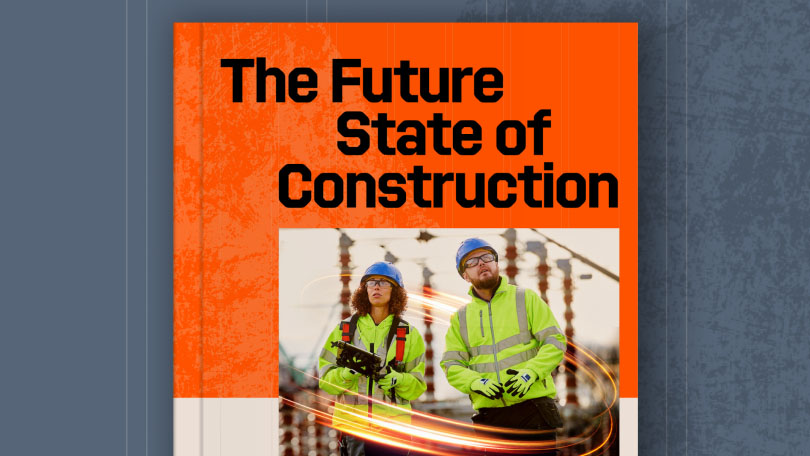— 12 min read
Streamlining the Buy-Out: Reducing Scope Gaps, Delays & Margin Erosion


Last Updated Sep 11, 2025

James Metcalfe
Solutions Consultant
James Metcalfe is a seasoned Procurement Specialist and Solutions Consultant at ProcurePro, bringing over a decade of hands-on experience in quantity surveying and procurement across new-build construction projects. Formerly a Quantity Surveyor at Wates Group, James built deep expertise in vendor management, cost control, and procurement processes in commercial construction. At ProcurePro, he leverages this background to help clients streamline procurement workflows, reduce costs, and enhance project delivery with scalable, technology-driven solutions.

Anna K. Cottrell
Writer and Editor
Anna K. Cottrell is a writer and researcher with an expertise in the property and finance sectors.
Last Updated Sep 11, 2025

Contributed by ProcurePro, a Procore Marketplace Partner
There isn’t a single construction project that doesn’t get impacted by how well—or poorly—the buyout phase is managed. In fact, the post-tender subcontract stage of the procurement process is crucial: it is where 70-80% of a project’s total cost is determined.
If it’s so important, why is the buy-out phase so often where things go wrong? The simple answer is: the accumulation of small errors and inefficiencies. Missed scope items, delayed packages, or unclear terms—combined, these can quickly escalate into significant delays, claims, and eroded profit margins. And in the vast majority of cases, the problem is not the competence or diligence of procurement professionals: it is the inefficiency of the processes they have traditionally employed to secure the buy-out.
The truth is that construction companies cannot afford the losses that result from these ‘small’ oversights. With UK contractors facing average net margins of less than 3%, every pound saved or protected during buy-out has a disproportionately positive impact on profitability.
How can the buy-out process be effectively streamlined? You’ve probably guessed it: digitisation. Digital procurement platforms (such as ProcurePro and Procore) are transforming the buy-out process from a chaotic mix of emails and spreadsheets into auditable, collaborative workflows. This shift accelerates awards, clarifies scope definitions, and helps identify risks earlier.
We spoke to James Metcalfe, a former Quantity Surveyor and now a Solutions Consultant, about his journey from old-school systems to pioneering new technology that is about to transform buy-out workflows—and save industry professionals a lot of money in the process. James shares practical insights gained from implementing buy-out best practices on high value projects.
Table of contents
The Three Common Buy-Out Issues: Scope Gaps, Delays, Late Variations
The good news is that all paths to margin erosion lead to the same main causes: scope gaps (when the construction pro doesn’t know what they’re buying and the contractor doesn’t know what they’re selling), procurement delays, and late-stage pricing fluctuations. The good news is that all three are preventable. However, most commercial directors/QSs learn this the hard way.
James certainly did. Long before his ProcurePro days, James was working on an offsite manufactured building for a new project. The design had been developed through the pre-construction services agreement stage. On the surface of it, everything was going smoothly: the buy-out had been agreed on as a lump sum to take it off the client’s hands; the intention was to get the main contract sealed and across the line.
What was the problem with this situation?
The due diligence was good, but it just wasn't enough. You've committed to something, you've taken a risk on it, but then the scope gaps start to appear. We were given one spec, the supplier had another spec, and then the client had another one. So we've got three different specs there, but we've already taken the risk.

James Metcalfe
Solutions Consultant
ProcurePro
In the (understandable) desire to be awarded the project, the company overlooked the complexity around connecting up the different dots, wrongly assuming that it had everything other than the foundations under control, procurement-wise.
The impact was drastic, we were looking at an over 20 week delay in just closing out design connections and other queries. Then, once we're on site, we've got another 10 weeks of delays, which is only impacting that program, in terms of the commercial impacts we were looking at 30 weeks of additional prelims. That is just a pure loss for our staff because you've got nowhere else to charge them to.

James Metcalfe
Solutions Consultant
ProcurePro
As for the financial impact, James quoted £10,000 a week for the liquidated damages, plus about £30,000 a week for the prelims. All told, over £1 million lost from the oversights during the buyout process.
The Solution: A Playbook for Streamlining Buy-Out
In terms of the shortest possible answer to the question, ‘What’s to be done?’ it is: have a plan and don’t ignore all the different threads of information. James recommends really looking into the data you as the buy-out professional have on hand: it will contain all the clues you need to what has gone wrong in the past and how to avoid similar mistakes in the future. Having all the data in one place helps enormously, solving the problem of time scarcity and the tendency to rush.
Everybody in construction is overly busy, nobody has the time to genuinely actually delve into the information and find out what the issue is, whereas now when you've got all of your data in one place, you don't have to delve into the information. It's not a time-consuming task. It's all brought to your attention. So you're not changing the ways you do anything. You're just recording that data and then the data is doing the work that you want it to do.

James Metcalfe
Solutions Consultant
ProcurePro
Mitigating Against Scope Gaps
Scope gaps are not inevitable. James’s main advice is to really study that profit plan in detail. Of course, a plan is a plan: it’s an indicator of the likely performance, not a 100% accurate representation of where the project's going to end up. Still, it’s a good guide based on the project’s cost and value.
As for the one big red flag that screams “scope gaps ahead”, it’s the budget’s big-ticket items. James recommends paying very close attention to items that have round quantities or rates.
If something's a thousand meter cubed and then it's a hundred pound rate, it's quite clearly a case of somebody's just plugged the figure.

James Metcalfe
Solutions Consultant
ProcurePro
Next, James recommends zooming in on sums of money within the packages that seem to have been produced out of thin air.
Think a little bit of a rogue rate: say, they've just chucked three grand against a standard item or ten grand against another item. So it would be clear to me that there was even no time for them to delve into what the actual item is. They couldn't source a price or they've just plucked a figure from their experience.

James Metcalfe
Solutions Consultant
ProcurePro
Overly neat or vague figures are especially a concern with higher-risk packages as opposed to easy items like clean or a mastic package. Think about it this way: can you afford a scope gap in this area? If it’s crucial, you really can’t.
Improving Workflows and Reducing Delays Through Digitisation
Did you know that on average, every trade takes around about 40 hours to complete the full buyout process? And that many procurement professionals spend a lot longer on your typical buy-out, closer to 50 or 60 hours?
Digital workflow management tools can drastically improve these timeframes. The figures speak for themselves. James tells us that a platform like ProcurePro delivers a minimum of 50% time-saving.
So we're looking at 20 hours per trade, not 40. And in some cases, the time savings are even more drastic than that.
We've got some customers that are taking hours. So as in single digits for complex trades, because they're purely focusing on the tender analysis and everything else is expedited and we've got other customers who are able to issue tenders within just minutes. All of the admin is reduced. And once that recommendation is made and through utilising digital approvals, what could have taken days or weeks across big complex companies is taking hours.

James Metcalfe
Solutions Consultant
ProcurePro
Contract preparation and signing times are vastly reduced too. In James’s experience, what used to take him a minimum of 45 minutes, can take as little as 15 minutes.
Preventing Margin Erosion With Live Dashboards & Reporting Analytics
As we’ve seen, errors during the buyout process can really eat into already thin margins. How exactly can buy-out streamlining prevent losses?
The answer is, for the most part, very simple: it’s having a straightforward, live view of all of your projects and all of your procurement in one place. Most commercial managers and directors are still accessing multiple projects across different shared drives; they request information over the phone, in meetings, and over email. In other words, they’re meticulously stringing together information about how the quotes have been returned and what the numbers are looking like. James is unequivocal about the impact of this way of doing things and the benefit of having everything centralised and digitised:
It's time-consuming, it's laborious. But if you have one dashboard that just shows all of your projects, you can jump into one project and you can see a target budget, an actual budget, and performance in one place. And it's taking you seconds rather than hours.

James Metcalfe
Solutions Consultant
ProcurePro
Beyond just time saving, this encourages a more collaborative and proactive approach to managing the buy-out. It allows a commercial director to make decisions earlier, way before the recommendation stage.
Once you get your first quote back, it's all in one place. Commercial managers, directors can just jump in there and they can go, ‘right, we've had our first quote back. What's it looking like compared to our budget?’ It's providing decision makers with the opportunities to understand where the risks may lie across their business.

James Metcalfe
Solutions Consultant
ProcurePro
Proactive planning is one way to mitigate margin erosion. Learning from past mistakes is another. The estimator’s handover report, for example, is a valuable source of information, including where a company may be losing money. Having detailed information on where the losses originated, not just the percentage, is crucial here.
Having all of the procurement information readily available in one place gives you the insights needed to spot patterns of losses between projects, too. James gives an example of a company that’s making a 10% loss across the business. How do you pinpoint where exactly the loss came from, which projects, which trades?
With a live dashboard, you may be able to see a trade that's always losing money, it's repeating itself on every project. But now you can actually see why: Is there a scope gap? Are we just pricing it wrong? Are our rates incorrect as well?

James Metcalfe
Solutions Consultant
ProcurePro
Digital dashboards provide insights for commercial directors to either take action or delegate action, prevent the reoccurrence, but also to highlight the good work that they do.
Tips for Mitigating Against Late Variations
Every buy-out process carries the risk of late pricing variations from subcontractors. It can’t be completely eliminated, but James offers some insights on how to spot a subcontractor who is clearly looking for variations.
The possibly surprising major red flag is a subcontractor who is being too nice and trying too hard to secure the contract. James admits that ‘too nice’ may sound like a fluffy term, but he makes what he means very clear with a real-life example:
We had a subcontractor who was absolutely spot-on the whole time through that RFQ process: quick to respond, kept giving us calls to ensure everything was correct, received all of the documents and was commercially attractive as well. So we completed all the necessary due diligence checks on the company, ensuring that they were spec compliant.
As soon as the contract was issued, they went back on their word regarding the agreement. A contractual battle started on t&c’s and every variation and change felt like an uphill battle, in a lot of cases they were chancing the change, just to try to win one.

James Metcalfe
Solutions Consultant
ProcurePro
The lesson to learn from this is: if it seems to be too good to be true, it probably is. A good contractor should be flexible, but if they’re not trying to negotiate at all, expect trouble later.
Questions to Ask a Subcontractor Before award
As part of this negotiation process, you should be able to quiz your estimators a bit on their figures. James recommends querying specific items, preferably over the phone:
I would try to understand exactly how they've got to the figure they've got to. And it would be pretty apparent that they don't have a clue if they've just gone silent. But usually they go silent because they think they've done their job. And again, that's that disconnected aspect of an estimator going, ‘the project's been won. I priced it as best as I can based on the information I had. I'm not going to have any more involvement in this. It's now over to the QS to deliver that project commercially successfully.’

James Metcalfe
Solutions Consultant
ProcurePro
So, it’s obvious that not all subcontractors are aiming for late variations; it’s just that not all want to do that thorough of a job with the pricing.
Benefits and Performance Improvements From Using Procurement Software
Beyond simply preventing the bad, what is the tangible good of implementing procurement software like Procore and ProcurePro? The benefits can be summarised as simply: change. James elaborates:
A dedicated procurement software like ProcurePro delivers a large change. Better insights across your business, faster results as well across your commercial teams, improved margins, but most importantly, you're going to have a more satisfied workforce because they're able to not be overloaded with work, doing the boring tasks, they're able to get rid of those tasks and just focus on what their job is.
As I say, being a QS, the main goal is to make as much money as possible in an ethically correct way.

James Metcalfe
Solutions Consultant
ProcurePro
Implementation considerations: is integrating procurement software difficult?
Changing old ways of working can be hard. Busy professionals especially may feel some trepidation about having to go through a drastic overhaul to their workflows. However, James stresses that this is not the case where it comes to integrating procurement software.
We built this platform to integrate into the industry standards. You're not actually changing anything that you do. You're just doing it in one software rather than doing it in your email, rather than doing it in your CDE platform for tendering and then back into Excel. It's literally it's the same process and you're just paying to have it in one place.

James Metcalfe
Solutions Consultant
ProcurePro
Categories:
Written by

James Metcalfe
Solutions Consultant | ProcurePro
James Metcalfe is a seasoned Procurement Specialist and Solutions Consultant at ProcurePro, bringing over a decade of hands-on experience in quantity surveying and procurement across new-build construction projects. Formerly a Quantity Surveyor at Wates Group, James built deep expertise in vendor management, cost control, and procurement processes in commercial construction. At ProcurePro, he leverages this background to help clients streamline procurement workflows, reduce costs, and enhance project delivery with scalable, technology-driven solutions.
View profile
Anna K. Cottrell
Writer and Editor | Freelance
Anna K. Cottrell is a writer and researcher with an expertise in the property and finance sectors.
View profileExplore more helpful resources

Construction Management Contracts: A Complete UK Guide
Managing construction contracts can lead to an extensive physical paper trail. Sharing contracts, getting signatures and managing timelines is difficult when teams and clients are scattered across job sites and...

Key Differences Between Contractors & Subcontractors
In UK commercial construction, main (or principal) contractors engage directly with project owners to deliver complete construction programmes, while subcontractors perform specific scopes of work under the main contractor’s management....

The Role of RFPs in UK Construction Projects
Requests for Proposals (RFPs) are a core document for construction procurement in the United Kingdom. Effective RFPs align expectations, establish clear evaluation criteria, and create accountability between clients and contractors....

Financial Management in Construction Projects
Effective financial management can make or break construction projects. Teams that master budgeting, cash flow and cost control are better positioned to deliver projects on time, within budget and with...
